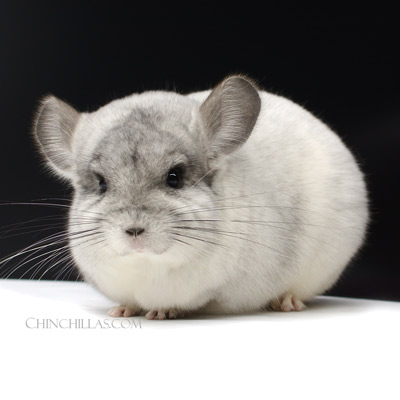Chinchilla Color and Fur Mutations

Below are tables detailing most, but not all, known chinchilla color and fur mutations.
Of note, the Wilson White and Gunning Black Velvet are 'lethal factor' genes, meaning they cannot exist in the homozygous form. Thus there are no known homozygous Wilson White or homozygous Gunning Black Velvet chinchillas. Breeding two Wilson Whites or Wilson White hybrids together will result in 25% fewer offspring than anticipated. Likewise, breeding two Gunning Black Velvet or Gunning Black Velvet (TOV) hybrids together will also result in 25 percent fewer offspring than anticipated.
 The Wilson White gene is also an incomplete dominant, meaning it does not express compete dominance or coverage in the phenotype. The underlying color can 'bleed through' in a variety of ways. The Wilson White gene can produce predominantly whites, white mosaics, or silvers, all being heterozygous Wilson White. The differences in phenotype are due to differences in gene expressions. Wilson White chinchillas are subjectively classified as follows:
The Wilson White gene is also an incomplete dominant, meaning it does not express compete dominance or coverage in the phenotype. The underlying color can 'bleed through' in a variety of ways. The Wilson White gene can produce predominantly whites, white mosaics, or silvers, all being heterozygous Wilson White. The differences in phenotype are due to differences in gene expressions. Wilson White chinchillas are subjectively classified as follows:
- Predominantly White chinchillas - range from nearly all white to white with a light distribution of dark guard hair
- White Mosaics chinchillas - include spotted and piebald appearing chinchillas
- Silver chinchillas - have an evenly distributed grey veiling tip and dark guard hair, giving these chinchillas a smooth silver-grey appearance
The Tower Beige gene is the only true dominant chinchilla color mutation gene that can exist in the homozygous form. All chinchillas with the Tower Beige gene, whether heterozygous or homozygous, or a hybrid such as tan, TOV beige, pink white, etc… will have red eyes. Heterozygous beige chinchillas tend to have darker red eyes, and homozygous beige chinchillas tend to have lighter red to pink eyes. Red eyes associated with the Tower Beige gene are not an indication of albinism.
| Dominant Mutation Name | Year | Breeder and Location |
| Wilson White (lethal factor / heterozygous only incomplete dominant) |
1955 | Blythe Wilson, Redding, CA, USA |
| Black / Gunning Black Velvet (lethal factor / heterozygous only dominant) |
late 1950's-early 1960's | Herb Chase, USA Robert Gunning, Davenport, WA, USA |
| Tower Beige (red eyes) |
1960 |
Nick Tower, USA |
| Busse | 1962 | Angle Ranch |
| Tasco | 1964 | Otto Munn, TX, USA |
| French Blue | 1970 | Jack French, KS, USA |
| Recessive Mutation Name | Year | Breeder and Location |
| Wellman Beige (dark eyes) |
1954 | |
| Rzewski Beige (dark eyes) |
1958 | Poland |
| Albino | 1960-1961 | Dennison |
| Long hair / Angora | early 1960's | Canadian breeder of Polish descent |
| Long hair / Angora | early-mid 1960's | Dr Caraway, Ft Worth, TX, USA |
| Long hair / Angora | 1966 | Roy Wilson, TX, USA |
| Recessive Beige (red eyes) |
1960's | L Sullivan & CJ Reynolds |
| Charcoal | Betty Broucke, CA, USA Wes Olson, CA, USA R Somavia, CA, USA W Pohl, CA, USA T Ready, CA, USA |
|
| Treadwell Black | 1962-1963 | Fort Worth, TX, USA |
| Sakrison (Curly Brown Charcoal) |
1963 | Lloyd Sakrison, MN, USA |
| Stone White | 1963 | Paul Stone, OK, USA |
| Larsen Sapphire | 1963-1965 | Merle Larsen, IN, USA |
| African/Sullivan Violet | 1967 | 'Mr. X,' Rhodesia, Africa Lloyd Sullivan, CA, USA |
| Young Lavender-Brown | 1969 | Bobby Young, Bartlesville, OK, USA |
| Lester Black (Midwest City Black) |
1970 | MW Lester, Midwest City, OK, USA |
| Goldbar | *1989-1990 | Bob and June Baar, CA, USA |
| True Dwarf | 1990's | Pete and Sue Kiseskey, CA, USA |
| Black Pearl | 2007 | Thomas and Elzbieta Kucharczak, Poland |
| Unspecified Mutation Name | Year | Breeder and Location |
| Fading White | early 1990's | PSK Chinchilla, Tehachapi, CA, USA (from Doug Wilson breeding stock, Lee's Summit, MO, USA) |
| Curly / Locken | 2000's | Germany |
Some data reproduced courtesy of the MCBA Archives. Includes subsequent amendments.